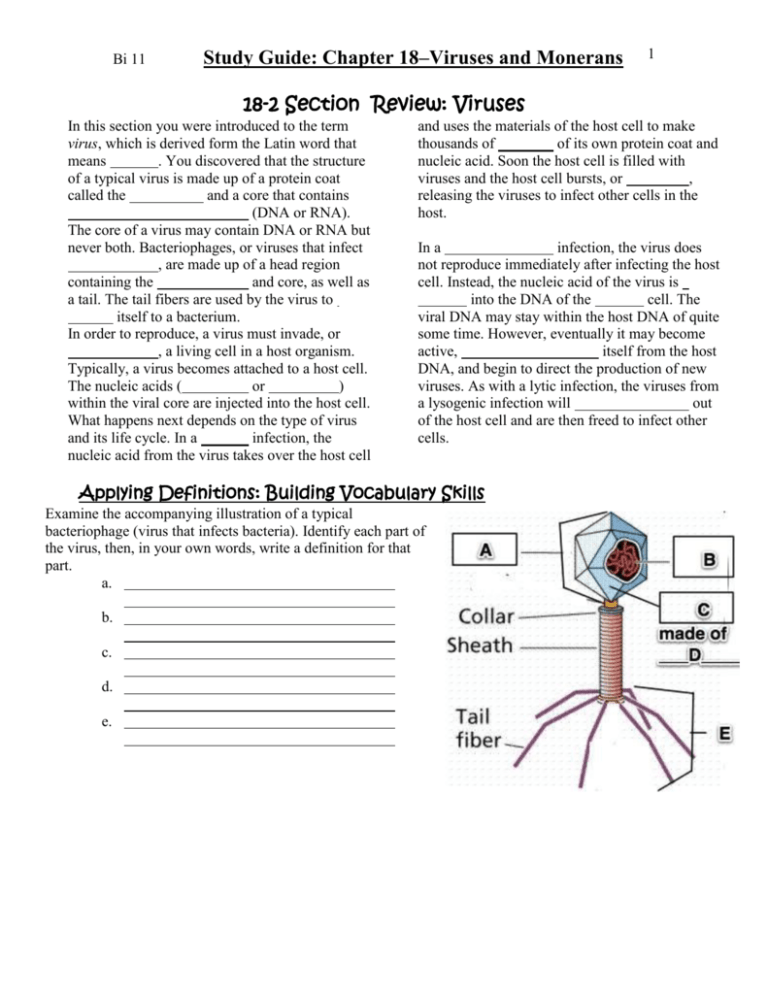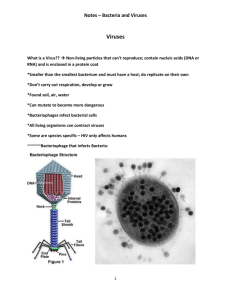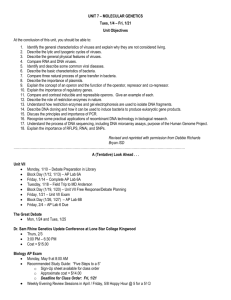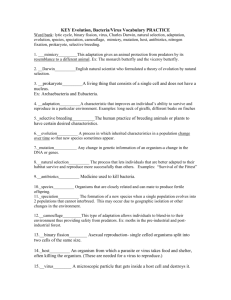Viruses & Monerans Study Guide: Chapter 18 Review
advertisement

Bi 11 Study Guide: Chapter 18–Viruses and Monerans 1 18-2 Section Review: Viruses In this section you were introduced to the term virus, which is derived form the Latin word that means . You discovered that the structure of a typical virus is made up of a protein coat called the and a core that contains (DNA or RNA). The core of a virus may contain DNA or RNA but never both. Bacteriophages, or viruses that infect , are made up of a head region containing the and core, as well as a tail. The tail fibers are used by the virus to itself to a bacterium. In order to reproduce, a virus must invade, or , a living cell in a host organism. Typically, a virus becomes attached to a host cell. The nucleic acids ( or ) within the viral core are injected into the host cell. What happens next depends on the type of virus and its life cycle. In a infection, the nucleic acid from the virus takes over the host cell and uses the materials of the host cell to make thousands of of its own protein coat and nucleic acid. Soon the host cell is filled with viruses and the host cell bursts, or , releasing the viruses to infect other cells in the host. In a infection, the virus does not reproduce immediately after infecting the host cell. Instead, the nucleic acid of the virus is into the DNA of the cell. The viral DNA may stay within the host DNA of quite some time. However, eventually it may become active, itself from the host DNA, and begin to direct the production of new viruses. As with a lytic infection, the viruses from a lysogenic infection will out of the host cell and are then freed to infect other cells. Applying Definitions: Building Vocabulary Skills Examine the accompanying illustration of a typical bacteriophage (virus that infects bacteria). Identify each part of the virus, then, in your own words, write a definition for that part. a. b. c. d. e. Bi 11 Study Guide: Chapter 18–Viruses and Monerans 2 Sequencing Events: Find the Main Idea. The stages in the life cycle of a lytic virus are scrambled in the accompanying illustrations. Examine the illustration carefully. Label the structures in the diagrams. a. Determine the correct order of the stages in the illustration. Put the letter of the first stage next to the line labeled Stage One. Follow the same procedure for each of the other four stages. Then describe what is occurring in each stage. When you are done, you will have correctly ordered and described the stages of a lytic infection. b. c. Stage One: ( ) Stage Two ( ) Stage Three ( ) d. Stage Four (___) Bi 11 Study Guide: Chapter 18–Viruses and Monerans 3 Concept Mapping Consider the concepts presented in Section 18-2 and how you would organize them into a concept map. Now, begin a concept map for Chapter 18 by adding the key facts and concepts you fell are important for Section 18-2. You will add to this concept map after you work with 18-1. When you have finished the chapter, you will have a completed concept map. Section 18-1: Monerans – Prokaryotic Cells In this section you were introduced to the bacteria, the single-celled organisms that make up the kingdom Monera. Bacteria are divided into four phyla: , Cyanobacteria, , and Prochlorobacteria. Bacteria are often identified by their . Bacteria can also be identified by the way in which their cell wall is colored by Staining. Bacteria obtain energy in a variety of ways. Some bacteria are , which use a source of energy such as or chemicals to produce food (organic molecules) from simple inorganic molecules. Other bacteria are , which cannot make their food and instead obtain energy from the organic molecules that they . The energy stored in food molecules is made available for use when the food molecules are down. Bacteria use the processes of respiration and fermentation to release the in food. Because bacteria release energy in various ways, their need for and tolerance of also varies. Bacteria reproduce by fission. Some bacteria also undergo other processes, such as and formation. During conjugation, genetic material is from one bacterium to another, thus creating new of genes. During one type of spore formation, a bacterium encloses its DNA with a thick internal wall to form a . The spore can survive conditions that would kill the bacterium in its active form. Bacteria fit into the world in many ways. For example, some bacteria help animals their food. Some are used in food and industry. Others convert nitrogen gas into a form that can be used by plants. Still others break down material and thus help recycle in the environments. Finding the Oddball: Building Vocabulary Skills For each of the following sets of terms, determine the characteristic common to three of the terms. Then identify the term that does not belong. 1. spirillum, coccus, methanogen, bacillus: 2. prokaryote, nitrogen fixation, saprophyte, symbiosis: 3. Eubacteria, Cyanobacteria, Archaebacteria, Azotobacteria: 4. cell wall, nucleus, flagellum, cytoplasm: Bi 11 Study Guide: Chapter 18–Viruses and Monerans 4 Labeling Diagrams: Using the Main Ideas Label the diagram of a typical bacterium using the following terms: capsid, cell membrane, cell wall, cytoplasm, flagellum, pilli, genetic material (DNA or RNA), ribosome, plasmid. Then answer the questions that follow the diagram. 1. Is the bacterium in the diagram a bacillus, coccus or spirillum? Explain. 2. How would you expect this bacterium to move? 3. Suppose that this bacterium was a streptobacillus. What kind of colonies would you expect to form? 4. This bacterium is Gram-negative. What happens when it is subjected to Gram staining? 5. This bacterium is a facultative aerobe. What process or processes would you expect it to use to break down food? Explain. Concept Mapping: Consider the concepts presented in Section 18-1 and how you would organize them into a concept map. Add the key facts and concepts you feel are important for Section 18-1 to the concept map you started with 18-2. When you have finished the chapter, you will have a completed concept map. Bi 11 Study Guide: Chapter 18–Viruses and Monerans 5 Diseases Caused by Viruses and Monerans In this section you learned that only a small number of viruses and bacteria are capable of producing in humans. You also read about ways in which viral and bacterial diseases can be treated and . Viruses cause human diseases such as polio, measles, and the common . Some viruses cause cancers in . Many viral diseases are prevented with . Most viral infections cannot be cured with , although medicines may help treat the of a viral disease. Scientists are currently studying interferons, proteins produced by virus-infected cells that make it difficult for the viruses to other cells. It is possible that many viral diseases may someday be cures using interferons. Bacteria cause human diseases such as tuberculosis, and tetanus. Bacterial diseases can also be treated with drugs such as . Controlling bacterial growth through and proper food processing can prevent bacterial infections. Defining Terms: Building Vocabulary Skills In your own words, define each of the following terms. 1. Antibiotic: 2. disinfectant: 3. Interferon: 4. Pathogen: 5. Sterilization: 6. Vaccine: Concept Mapping Consider the concepts presented above and how you would organize them into a concept map. Now, add the key facts and concepts you feel are important for this section. When you have finished you should have a completed concept map. Bi 11 Study Guide: Chapter 18–Viruses and Monerans Chapter 18 Concept Map: 6









